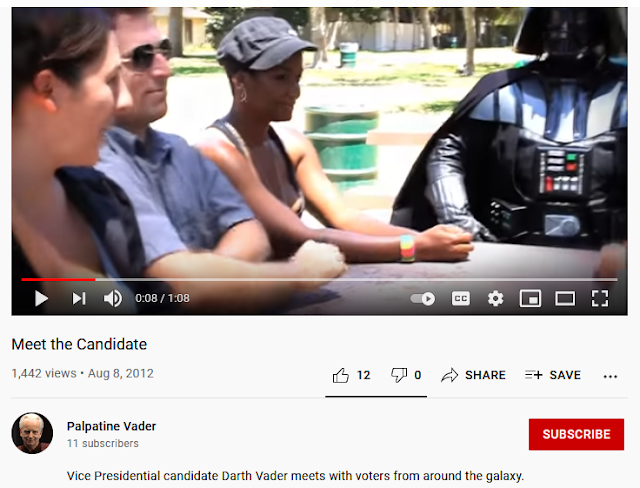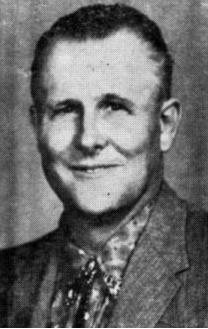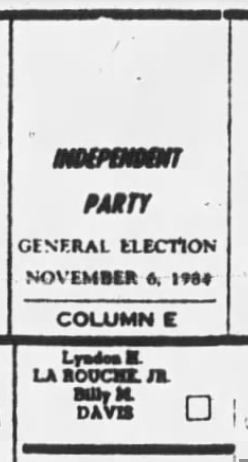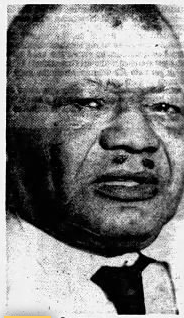Vacant
VP candidate for Independent (1984, 1988, 1996, 2000, 2004, 2008)
Running mate with nominee: Robert Bryant Winn (b. 1943)
Popular vote (1984, 1988, 1996, 2000, 2004, 2008): ? (0.00%)
Electoral vote (1984, 1988, 1996, 2000, 2004, 2008): 0/538
The campaigns (1984, 1988, 1996, 2000, 2004, 2008):
Occasionally there are Presidential candidates who are very pointed about NOT having a running-mate, and I try to cover their reasons if possible.
Robert B. Winn is a perennial Independent candidate in Arizona who has run for Governor and US Senator always as a write-in. In 1988, 1996, 2000 and 2004 he ran in the same manner for US President. In 1984 he actually made the Arizona ballot, and received 3 votes for President.
A Vietnam veteran, welder and laborer, Winn had a religious background in the Church of the Latter Day Saints and in his resume are included the intriguing but unexplained entries "Prisoner, Maricopa County, Arizona, 1992 -- Prisoner, Veterans' Affairs Hospital, Psychiatric Ward, 1970." A long time advocate and activist for independent political parties, he has written a few books and has been a prolific online author.
Although Winn did have a political platform, he deemed it "irrelevant" and made the simple fact he was not running under the banner of one of the major parties the main focus of his campaigns. Some of the reviews of his published material suggest he has a conspiratorial-minded political outlook.
So far as I can tell, Winn never had a running-mate and that seemed to be the result of a deliberate decision.
Winn made the following comment on the
Third Party Watch blog regarding the election and function of the Vice-President--
Robert B. Winn Says:
January 1st, 2008 at 1:17 am
You third party people have not fully considered what it means to be independent. Why would anyone want to be a party wannabe. As an actual independent voter, I can register as a candidate for President with the Federal Election Commission the same way George Washington did, without a vice-President running mate. Party wannabes have not yet seen what an advantage this gives the independent voter who is registered as a candidate for President.
This splits the political party vote. Who will be vice-President if an independent voter is elected President?
Well, obviously, the party vice-Presidential candidate who gets the most votes will become vice-President of the United States, since the independent voter elected President has no running mate. The duties of the vice-President are to preside over the Senate. John Nance Garner said that this job was not worth a bucket of warm spit. It should go to a political party candidate. So we will have an independent voter as President and a party politician in the vice-Presidency, even though that party’s Presidential candidate lost the election.
Match that, political party wannabes.
Actually, the Republican-Democrat Party started this anomaly by running two candidates for President in the election of 1800. Now that makes more sense. Abraham Lincoln was elected because the opposing party ran more than one candidate. Two Democrat candidates in 1860 seemed to have a good effect, until it resulted in party primaries and all the political party wannabes of today.
A real independent runs without a running mate. This running mate thing has always seemed a little suspect to me. I would rather have a Political party vice-President who just tends to his job of presiding over the Senate, except in the case of an impeachment trial, when he would be replaced by the Chief Justice of the Supreme Court.
In any event, a political party wannabe candidate for vice-President will never defeat a political party vice-Presidential candidate because of the twelfth amendment to the Constitution. An independent vice-Presidential candidate running separate from all independent Presidential candidates could defeat a party vice-Presidential candidate, but there is no record I have seen of any independent voters running for vice-President outside of the party wannabe running mate method.
Winn also made a comment for the
New York Sun along the same lines:
Robert B. Winn • Nov 13, 2007 at 08:04
The idea of a vice-Presidential running mate came from the election of 1800 when the Republican-Democrats ran two candidates for President, Thomas Jefferson and Aaron Burr, to prevent the Federalist followers of Alexander Hamilton from gaining the office of vice-President. When the electors of the electoral college met, all of the Republican-Democrat electors voted for Jefferson and Burr, resulting in a tie vote for President. Burr, who was supposed to be running for vice-President, started campaigning for Federalist support in the House of Representatives, and it took about 38 votes in the House before Jefferson was elected.
Members of Congress considered this to be so traumatic that they passed an amendment resulting in the present day running-mate system for Presidential and vice-Presidential candidates. The way for independent voters to break the hold that parties have on these two offices is to run Presidential and vice-Presidential candidates separate, several Presidential candidates and several vice-Presidential candidates on election day.
It costs the American people billions of dollars per election to put two corrupt sets of party running mates on the ballot. Put some independent candidates on the ballot using nomination petition signatures instead of money.
Robert B. Winn
In 2019 there as an effort called Vice.run that had a mission to "reclaim our constitutional right to democratically elect the vice president by creating separate ballot lines for vice presidential candidates in the 2020 election, as per the 12th Amendment. Vice.run will secure signature pledges to use standing ballot access laws in each state to initiate this change." I had contacted this group. They agreed to be interviewed. I put in the time to research for the questions and sent them in, and that was the last I heard. Actually, some political candidates have brushed me off the same way after they gave the green light and I put in all the effort to write the questions. But in the case of Vice.run it looks like the organization just ceased to exist about the same time I sent them my list of queries.
So, just for the heck of it, here were the questions I had for Vice.run, which I will dovetail off of Mr. Winn's thought-provoking comments--
Oct 3, 2019, 7:39 AM
Vice.run was created by Mikel and David Blake, education and workforce entrepreneurs currently based in San Francisco.
Their mission, as told on their website:
"Vice.run grows from a kernel of an idea: 'All the ills of democracy can be cured by more democracy' and that the vice presidency is an undemocratic anomaly in American politics. It’s an extremely important elected office whose occupant we do not choose.
Mikel & David launched vice.run to 'act anew' to fix this anomaly and reinstate the vice presidency as a democratically elected position. Vice.run’s goal is to create a vice presidential ballot line in the 2020 election in all 50 states.
Since national elections are managed at the state-level, we have state-level goals and are growing our state-level operations. Our very first organizing effort is collecting ballot-access pledges calling on states to create a separate ballot line for the vice president."
And here is what I would call their thesis statement:
"The Constitution gives the American people the right to choose the vice president of the United States. That right was taken from us by the party ballot. That lack of democracy has corrupted the office, turning it into a presidential lap dog, instead of a representative of 'We the People.'
It’s time for that approach to change. It’s time to reclaim the vice presidency for the American people. It’s time for us to elect the vice president.'"
David Blake, co-founder of vice.run
https://vice.run/
--------------------------------------------------------------
Q: What exactly provided the spark for this movement? Were the Blakes at all politically active before vice.run was created?
Q: If the presentation of a party ticket is the result of custom rather than legality, why has this been allowed to exist so long without being challenged? Or have there been other efforts similar to yours in the past?
Q: Devil's advocate here. Shouldn't the parties have a right to select their own solid ticket?
Q: Part of the 12th Amendment states "The Electors shall meet in their respective states, and vote by ballot for President and Vice-President, one of whom, at least, shall not be an inhabitant of the same state with themselves ..." -- This has never really been tested. But in your model it could happen by chance. Then what?
Q: Do the recent efforts to eliminate the Electoral College complicate or help your mission in any way?
Q: In every political process there always seems to be an opportunity for mischief. In 1860 there was an alleged plot to deadlock the presidential vote in the House in the event of no electoral winner, and with the absence of a President the Senate would elect the pro-slavery running mate Joseph Lane of the Constitutional Democratic Party who would then ascend to the presidency. Have you identified any other sort of loopholes in the system regarding Vice-Presidents and what can be done about them?
Q: I recall that after the JFK assassination the US was without a Vice-President and then the 25th Amendment was enacted, allowing the sitting President to appoint a new VP, which was later the case with Gerald Ford in 1973 and Nelson Rockefeller in 1974. Should that process also be changed and if so, how?
Q: Half of the states have a baked-in system, part of election law, where the Governor and Lt. Governor are elected as a ticket. Do you have plans to try and change that as well?
Q: What part of the political spectrum are you getting the most positive response from? Have you been able to determine the demographics of your support? Do you find yourself building alliances with other organizations in this process and who are they?
Q: Are you experiencing any pushback and if so, from where?
Q: Gone are the days when Wilson's VP, Thomas Marshall said, "Once there were two brothers. One ran away to sea, the other was elected Vice President, and nothing was ever heard of either of them again." Some modern VPs have been able to involve themselves, basically under the public radar, in schemes that had enormous consequences for our country-- for example the VPs Nixon and Cheney getting their hands dirty with clandestine foreign operations and performing end runs around due process. How does your model make the Vice-President more accountable?
Q: How goes the battle with the state by state effort? Do you have benchmarks set for 2020? 2024?
Q: Is the vice.run project giving anyone in the central team ideas for broader political ambitions? Can we expect to see any of you running for office?
Q: Thanks very much for taking the time to answer my questions. Anything you would like to add?
Election history: none
Other occupations: none
Notes:
Winn was a Republican until 1973, when he left the Party due to Watergate.






















































